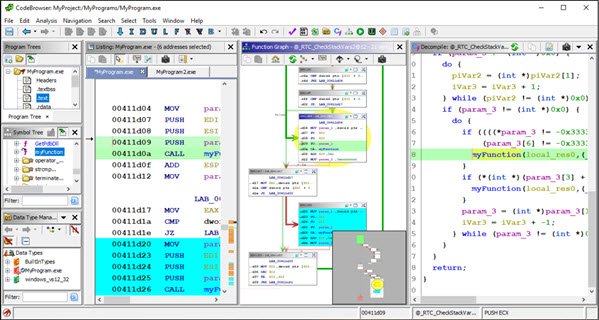GHIDRA is a software reverse engineering (SRE) framework that helps analyze malicious code and malware-like viruses. It has been created and maintained by the National Security Agency Research Directorate. Now if that sounds a bit scary, this tool isn’t getting installed on your devices. It has been developed to fight against malware and viruses so that they can be stopped. It also makes it possible to find potential vulnerabilities in networks and systems. This post offers an overview of the GHIDRA reverse engineering tool from the NSA.
GHIDRA reverse engineering tool

The framework includes a software analysis tool that allows users or techies to analyze compiled software. Complied software, in simple words, means EXE files or final code that can run software on your computer. This tool reverses engineers to reach source code or at least part of which can make sense. Capabilities include disassembly, assembly, decompilation, graphing, and scripting, and more.
It’s open source, which means the community can contribute both to source code or can build plugins to extend. You can use Java or Python to develop it. That said, it isn’t just a desktop tool. GHIDRA is built to scale and solve teaming problems on a sophisticated level. According to NSA
Ghidra SRE capabilities to a variety of problems. It can involve analyzing malicious code and generating deep insights for SRE analysts. It will help them in a better understanding of potential vulnerabilities in networks and systems.
Ghidra starts from Binary Code to Annotated assembly and ends up to the final source code. In simple words, this software can convert all those 1’s and 0’s into human understandable language. The framework also offers a user interface instead of a boring command line. It makes things easier for many.
Key features of GHIDRA
- Includes a suite of software analysis tools. It analyzes compiled code on a variety of platforms including Windows, macOS, and Linux.
- Supports a wide variety of processor instruction sets and executable formats.
- It can run in both user-interactive and automatic modes.
- Users may develop their plugins or scripts using open API.

Looking at this, it makes me wonder why NSA went ahead and open sourced it. Imagine this tool in the hands of hackers. They can read your source code, find the hack and write malware for it. Then you can go ahead and see the crack for the same using the same tool. It’s an infinite loop if two parties get at it.
Hopefully, we will get to see more talents in improving this software, and it is useful in better ways.
Read the GHIDRA presentation notes for details. It is available for download at Github. You may want to also read this thread on Reddit.
Fun Fact: WikiLeaks first revealed the existence of Ghidra in 2017. However, the software was made official in the public domain in 2019.